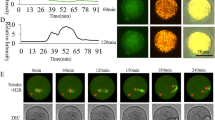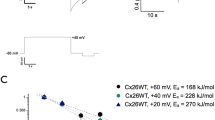Abstract
The relationship among intracellular pH (pHi), −log10 intracellular Ca2+ concentration (pCai) and gap junctional conductance, the participation of Ca2+ stores, and the role of calmodulin in channel regulation have been studied inXenopus oocytes, expressing the native connexin (Cx38), exposed to external solutions bubbled with 100% CO2. The time courses of pHi [measured with 2′,7′-bis(2-carboxyethyl)-5,6-carboxylluorscein (BCECF)], (pCai) (measured with the membrane-associated fura-C18) and junctional conductance (measured with a double voltage-clamp protocol) were compared. The data obtained confirm previous evidence for a closer relationship of junctional conductance with (pCai) than with pHi. Evidence for an inhibitory effect of intracellularly injected ruthenium red or 1,2-bis(2-aminophenoxy)ethane-N,N,N′,N′-tetraacetic acid (BAPTA) on CO2-induced uncoupling, coupled to negative results with Ca2+-free external solutions, point to a low-pHi-induced Ca2+ release from internal stores, likely to be primarily mitochondria. The hypothesis proposing a participation of calmodulin in channel gating was tested by studying the effects of calmodulin expression inhibition by intracellular injection of oligonucleotides antisense to the two calmodulin mRNAs expressed in the oocytes. Calmodulin mRNA was permanently eliminated in 5 h. The oocytes injected with the antisense nucleotides progressively lost the capacity to uncouple with CO2 within 72 h. The effect of CO2 on junctional conductance was reduced by ≈60% in 24 h, by ≈76% in 48 h and by ≈93% in 72 h. Oocytes that had lost gating sensitivity to CO2. partially recovered gating competency following calmodulin injection. The data suggest that lowered pHi uncouples gap junctions by a Ca2+-calmodulin-mediated mechanism.
Similar content being viewed by others
References
Bancel F, Salmon JM, Vigo J, Vo-Dinh T, Viallet P (1992) Investigation of noncalcium interactions of fura-2 by classical and synchronous fluorescence spectroscopy. Anal Bioche 204:231–238
Bennett MVL, Verselis RL, White RL, Spray DC (1988) Gap junctional conductance: gating. In: Hertzberg EL, Johnson RG (eds) Gap junctions. Liss, New York, pp 207–304
Cairns SP, Westerblad H, Allen DG (1993) Changes in myoplasmic pH and calcium concentration during exposure to lactate in isolated rat ventricular myocytes. J Physiol (Lond) 464:561–574
Chafouleas JG, Pardue RL, Brinkley BR, Dedman JR, Means AR (1981) Regulation of intracellular levels of calmodulin and tubulin in normal and transformed cells. Proc Natl Acad Sci USA 78:996–1000
Chien YH, Dawid IB (1984) Isolation and characterization of calmodulin genes from Xenopus laevis. Mol Cell Biol 4:507–513
Chomczynski P, Sacchi N (1987) Single-step method of RNA isolation by acid guanidinium thiocyanate-phenol-chloroform extraction. Anal Biochem 162:156–159
Dash P, Lotan I, Knapp M, Kandel ER, Goelet P (1987) Selective elimination of mRNAs in vivo: complementary oligodeoxynucleotides promote RNA degradation by an RNase H-like activity. Proc Natl Acad Sci USA 84:7896–7900
Délèze J (1965) Calcium ions and the healing-over in heart fibers. In: Taccardi B, Marchetti C (eds) Electrophysiology of the heart. Pergamon, Elmsford, N.Y., pp 147–148
De Mello WC (1975) Effect of intracellular injection of calcium and strontium on cell communication in heart. J Physiol (Lond) 250:231–245
Etter EF, Kuhn MA, Fay FS (1994) Detection of changes in near-membrane Ca2+ concentration using a novel membraneassociated Ca2+ indicator. J Biol Chem 269:10141–10149
Fujimoto K, Araki N, Ogawa K-S, Kondo S, Kitaoka T, Ogawa K (1989) Ultracytochemistry of calmodulin binding sites in myocardial cells by staining of frozen thin sections with colloidal gold-labeled calmodulin. J Histochem Cytochem 37:249–256
Gambassi G, Hansford RG, Sollott SJ, Hogue BA, Lakatta EG, Capogrossi MC (1993) Effects of acidosis on resting cytosolic and mitochondrial Ca2+ in mammalian myocardium. J Gen Physiol 102:575–597
Gunter TE, Gunter KK, Shen SS, Gavin CE (1994) Mitochondrial calcium transport: physiological and pathological relevance. Am J Physiol 267:C313-C339
Hertzberg EL, Gilula NB (1981) Liver gap junctions and lens fiber junctions: comparative analysis and calmodulin interaction. Cold Spring Harbor Symp Quant Biol 46:639–645
Lazrak A, Peracchia C (1993) Gap junction gating sensitivity to physiological internal calcium regardless of pH in Novikoff hepatoma cells. Biophys J 65:2002–2012
Lea TJ, Ashley CC (1981) Carbon dioxide or bicarbonate ions release Ca2+ from internal stores in crustacean myofibrillar bundles. J Membr Biol 61:115–125
Leonard JP, Nargeot J, Snutch TO, Davidson N, Lester HA (1987) Ca channels induced in Xenopus oocytes by rat brain mRNA. J Neurosci 7:875–881
Loewenstein WR (1966) Permeability of membrane junctions. Ann NY Acad Sci 137:441–472
Muravjova A, Dunina-Barkovskaya Y, Margolis LB (1995) Intracellular pH and intercellular junctional conductance. Biol Membr 7:511–518
Peracchia C (1984) Communicating junctions and calmodulin. Inhibition of electrical uncoupling in Xenopus embryo by calmidazolium. J Membr Biol 81:49–58
Peracchia C (1987) Calmodulin-like proteins and communicating junctions. Electrical uncoupling of crayfish axons is inhibited by the calmodulin inhibitor W7 and is not affected by cyclic nucleotides. Pflügers Arch 408:379–385
Peracchia C (1987) Permeability and regulation of gap junction channels in cells and in artificial lipid bilayers. In: De Mello WC (ed) Cell-to-cell communication. Plenum, Elmsford, N.Y., pp 65–102
Peracchia C (1988) The calmodulin hypothesis for gap junction regulation six years later. In: Hertzberg EL, Johnson RG (eds) Gap junctions. Liss, New York, pp 267–282
Peracchia C (1990) Increase in gap junction resistance with acidification in crayfish septate axons is closely related to changes in intracellular calcium but not hydrogen ion concentration. J Membr Biol 113:75–92
Peracchia C (1990) Effects of caffeine and ryanodine on low pHi-induced changes in gap junction conductance and calcium concentration in crayfish septate axons. J Membr Biol 117:79–89
Peracchia C (1995) Evidence for a role of calcineurin in gap junction regulation. Proceedings of the 1995 Gap Junction Conference. L'Ile des Embiez, France
Peracchia C, Bernardini G, Peracchia LL (1983) Is calmodulin involved in the regulation of gap junction permeability? Pflügers Arch 399:152–154
Peracchia C, Lazrak A, Peracchia LL (1994) Molecular models of channel interaction and gating in gap junctions. In: Peracchia C (ed) Handbook of membrane channels. Molecular and cellular physiology. Academic, San Diego, pp 361–377
Peracchia C, Wang X, Lazrak A, Peracchia LL (1995) Potential role of calcineurin in gap junction channel gating. Biophys J 68:A226
Pressler ML (1989) Intracellular pH and cell-to-cell transmission in sheep Purkinje fibers. Biophys J 55:53–65
Ramón F, Rivera A (1987) Gap junction channel modulation: a physiological viewpoint. Prog Biophys Mol Biol 48:127–153
Rose B, Loewenstein WR (1975) Permeability of cell junction depends on local cytoplasmic calcium activity. Nature 254:250–252
Spray DC, Harris AL, Bennett MVL (1981) Gap junctional conductance is a simple and sensitive function of intracellular pH. Science 211:712–715
Toyama J, Sugiura H, Kamiya K, Kodama I, Terasawa M, Hidaka H (1994) Ca2+-calmodulin mediated modulation of the electrical coupling of ventricular myocytes isolated from guinea pig heart. J Mol Cell Cardiol 26:1007–1015
Turin L, Warner AE (1977) Carbon dioxide reversibly abolishes ionic communication between cells of early amphibian embryo. Nature 270:56–57
Turin L, Warner AE (1980) Intracellular pH in early Xenopus embryos: its effect on current flow between blastomeres. J Physiol (Lond) 300:489–504
Zimmer PB, Green CR, Evans HW, Gilula NB (1987) Topological analysis of the major protein in isolated intact rat liver gap junctions and gap junction-derived single membrane structures. J Biol Chem 262:7751–7763
Ziegelstein RC, Cheng L, Blank PS, Spurgeon HA, Lakatta EG, Hansford RG, Capogrossi MC (1993) Modulation of calcium homeostasis in cultured endothelial cells by intracellular acidification. Am J Physiol 265:H1424-H1433
Author information
Authors and Affiliations
Rights and permissions
About this article
Cite this article
Peracchia, C., Wang, X., Li, L. et al. Inhibition of calmodulin expression prevents low-pH-induced gap junction uncoupling inXenopus oocytes. Pflugers Arch. 431, 379–387 (1996). https://doi.org/10.1007/BF02207275
Received:
Revised:
Issue Date:
DOI: https://doi.org/10.1007/BF02207275




